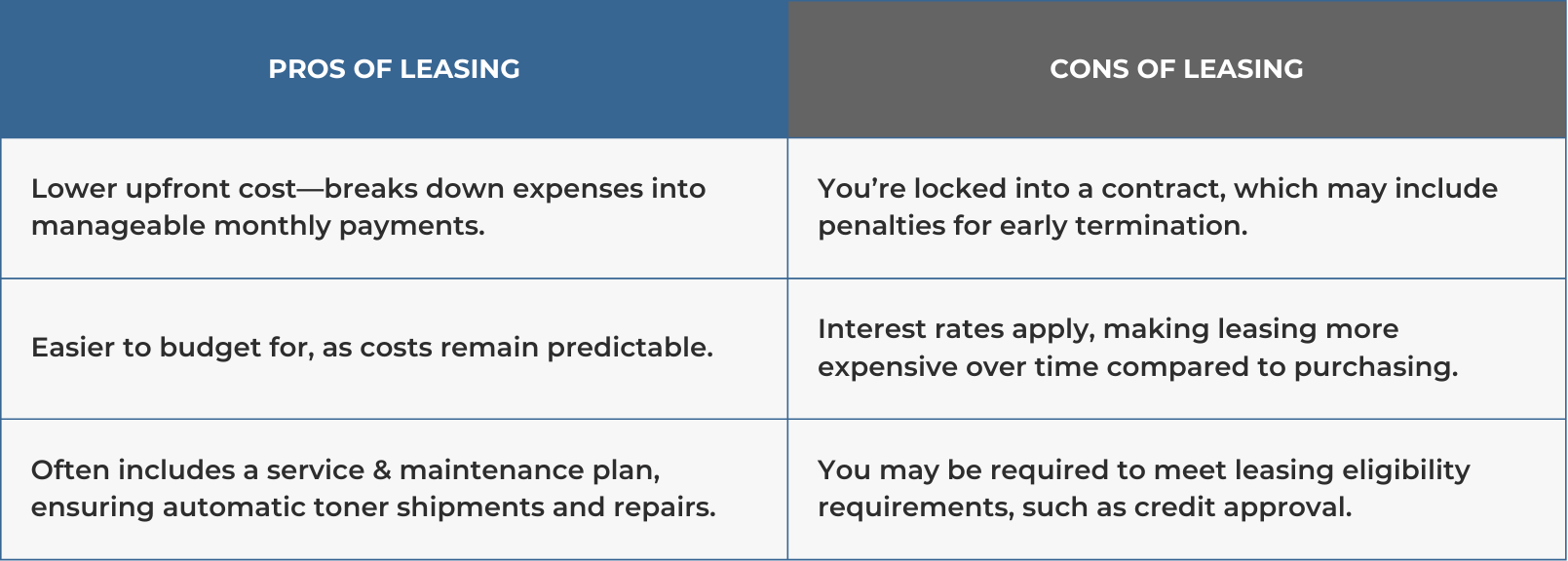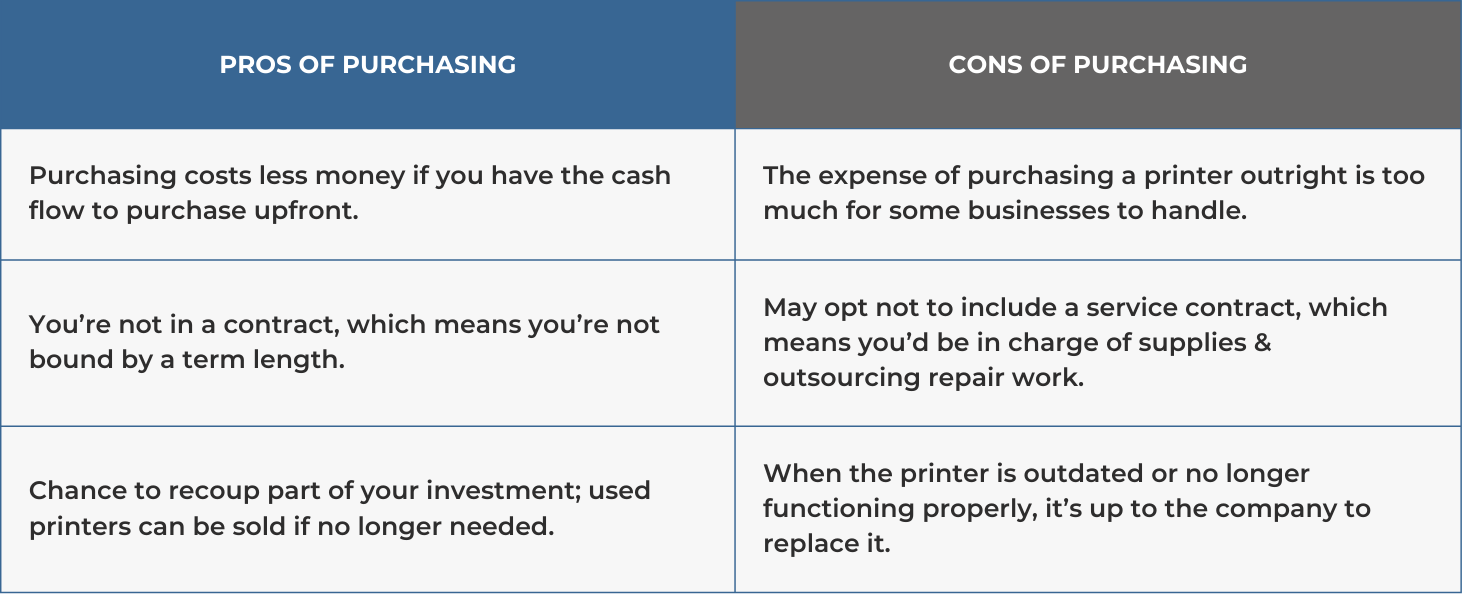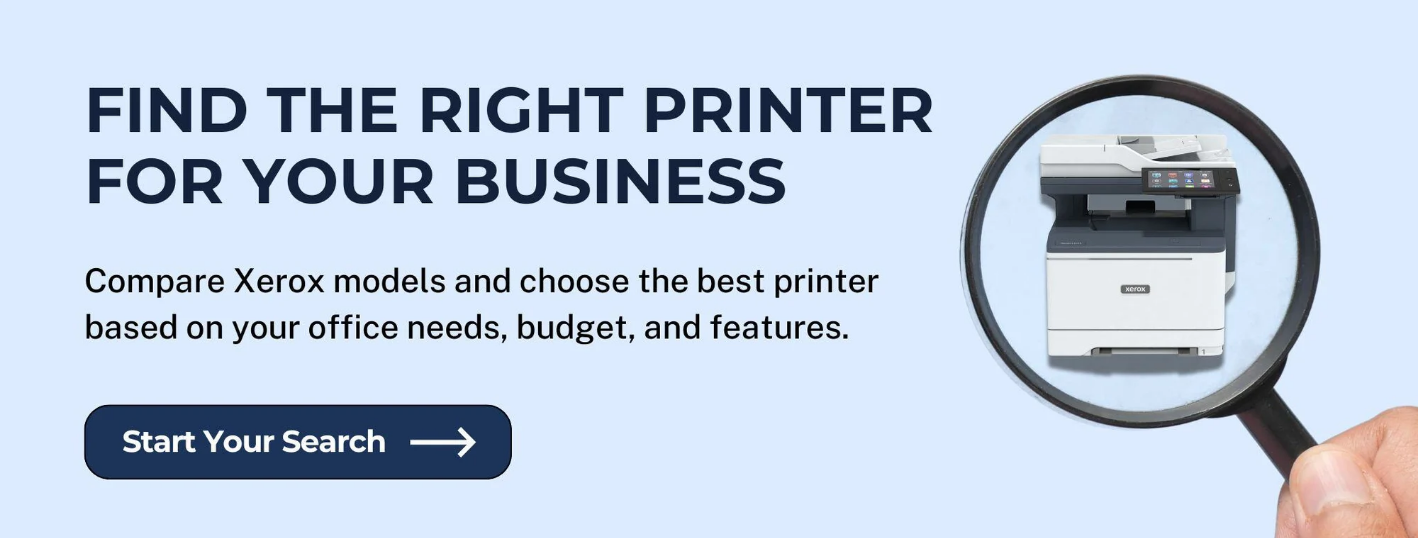
Two payment options reign supreme in the world of office equipment: Leasing and purchasing.
Which one is the better option for you?
As a local print vendor of nearly 40 years, we’ve dealt with the leasing vs. purchasing question in almost every sales interaction we’ve had. We know firsthand the intricacies that go into each option.
While there are other acceptable forms of payment in the printer/copier industry, such as credit cards and personal financing, they will not be universal to all print providers or vendors.
Therefore, informing yourself of the two most common forms of payment in the office equipment sector is crucial to determining how you’re going to pay for your next machine.
Before deciding, make sure you're asking the right questions when choosing a print vendor.
Read: Top 10 Questions to Ask Your Print Provider Before Purchasing to ensure you’re making an informed decision.
We will use our industry expertise to clearly outline the advantages and disadvantages of the two payment options. This will give you a complete understanding of each option, helping you choose the one that best fits your budget.
Related Reading: 5 Things to Avoid When Buying a Printer/Copier
2 Pros of Leasing a Printer
To kick things off, let’s start with two prominent pros of leasing a printer:
1. Breaks Total Cost into Monthly Payments
The obvious and most notable advantage of leasing a printer is that it breaks down the total cost of the machine into more affordable monthly payments.
There’s no getting around it: Modern-day printers are expensive, with advanced multifunction printers(print, copy, scan and fax) and production-style printers ranging from $10,000-$100,000 in some instances.
Most businesses don’t have the budget or desire to pay out-of-pocket for a printer over $5,000, which is why leasing tends to be the most common form of payment in the industry.
Want to better understand copier lease agreements? Check out our Guide to Copier Lease Agreements.
2. Easier to Budget For
Building on the last point, breaking down the total cost of a machine into monthly payments is easier for most companies to manage because they avoid a large upfront expense.
Many companies prefer to spread out the total cost so they can allocate their budget to other areas that are more important for reaching their revenue goals. It can also offer tax advantages. Consult your financial advisor to see if this applies to your business.
Leasing is popular among consumers, especially when the office machine they want costs over $5,000, because it provides affordability and relief on their budgets.
Want to make your printer investment even more cost-effective? Check out our blog on 3 Tips for Saving Money on Your Next Printer/Copier for practical ways to reduce costs while ensuring you get the right device for your business.
3 Cons of Leasing a Printer
Now that you’ve seen the pros, let’s give you the other side with the three cons to leasing a printer:
1. You Are in a Contract
Just like entering into a lease agreement for your apartment, a lease for your printer means you are in a contract, and there will be financial consequences if you need to break it.
If you need to get out of your lease before it expires, you will have to pay a cancellation fee, which is determined by the leasing company. There can also be extra early termination fees if you decide to break your lease agreement.
Before entering into a lease, make sure to evaluate your work environment and account for how many employees you have and may add in the future, so you avoid leasing a machine that is inadequate for your situation.
Avoid hidden pitfalls—know what to look for. Read: 10 Red Flags to Look for in Your Printer Contract.
2. Interest Expense Can Apply
Another downside to leasing a printer is that interest expense can apply, and they can be higher than what your personal bank or credit union would offer.
Because of interest expenses, leasing a printer will be more expensive in the long run than purchasing one outright would be.
What are escalation clauses, and how do they impact your lease? Learn About Escalations in Printer Contracts.
3. Must Meet Leasing Eligibility Requirements
To lease a machine, you must first meet the eligibility requirements to ensure you qualify for the payment option.
Some vendors require a minimum product price to approve you for leasing.
For instance, if a provider has a $1,000 minimum for leasing a machine, the total cost of the printer you wish to lease needs to be at least $1,000 to qualify.
You must also obtain prior credit approval to fulfill the lease eligibility requirements with certain vendors or providers.
Considering switching to leasing? 5 Signs It's Time to Switch to Leasing Your Copier.

3 Pros of Purchasing a Printer
We’ve looked at what leasing a printer entails, so let’s now shift our focus to the purchasing option, starting with the pros:
1. Save More Money in the Long Run
If you have the cash flow to purchase a printer outright, you should do it every time. Even though it may cost you more initially, it will save you more in the long term.
This is mainly because you won't have to worry about interest expenses, and while you can still place your machine under a service contract, you won’t be required to have one as you typically would in a lease agreement.
However, as you'll see in the cons section of the purchasing option, many businesses don’t have the budget to spend thousands of dollars on a printer, and forgoing a service contract could be risky.
Need help choosing the right printer? Read: How to Choose a Printer for Your Budget and Business Needs.
2. You Won’t Be Bound by a Contract
Being in a contract of any kind can be intimidating, so a notable advantage to purchasing a printer outright is you won’t be tied down to a contract like you would in a lease.
Because you won’t be under a contract, you won’t be confined to a certain time period and can choose when you want to upgrade or get rid of the machine.
You can still opt for a maintenance or service contract, if desired, but it will not be required under the purchasing option.
3. You Can Recoup Some of Your Investment
By purchasing your machine, you become its sole owner, allowing you to eventually sell it when it’s no longer needed in your office.
However, you shouldn’t expect a major return. Printers are depreciating assets, and if you’ve used the machine consistently over a long period, it’s unlikely to provide a significant financial return for you.
3 Cons of Purchasing a Printer
Let’s now take a look at a few of the major cons to purchasing a printer outright:
1. Requires a Hefty Short-Term Cost
The ultimate disadvantage to choosing the purchasing option for your next printer is you have to pay for it in full upfront.
When you’re talking about machines that can run over $5,000, there are very few businesses that can incur such a cost and still have adequate working capital left over.
It’s the reason why leasing is the option of choice for many consumers, even though purchasing would save you more in the long run.
Want to understand printer pricing? Read: How Much Does a Printer/Copier Cost?
2. Access to Automatic Toner and Service May Not Be Included
If you decide to purchase your printer, you won’t be required to add a service contract with it, which means you may opt-out of paying for one.
However, without a maintenance plan, you won’t have access to automatic toner shipments, which, as discussed earlier, can lead you to overspend on supplies you don’t need.
Not including a maintenance plan means you will also have to outsource printer repair work. Printer service technicians can charge more than $100 an hour, and if the issue with your machine is complex, that bill can become costly. Learn more about the cost of printer service here.
Plus, you’ll have to pay for any parts you might need to replace with your machine. Learn more about the cost of printer supplies here.
Consider a maintenance plan for your purchased printer. What Are STPT’s Maintenance Plans?
3. It’s Harder to Find a Replacement Printer If Needed
Say your printer has an elaborate service issue or stops working altogether: Where do you get a replacement?
If you have a lease agreement, your provider is more likely to offer you a temporary replacement if something goes wrong with the machine you leased, but this isn't guaranteed.
While you can still find a replacement if you decide to buy the machine, it will be harder to do so without help from a provider.

Should You Lease or Purchase Your Printer?
As discussed in this article, both leasing and purchasing have their pros and cons. The answer depends on your business’s financial situation and long-term goals. Here’s a simple rule of thumb:
- If you can afford to pay for a printer upfront, purchasing is the most cost-effective option. It saves you money on interest.
- If you need to spread out costs, leasing will be the better choice.
Ask yourself this question before deciding: Can I afford to pay for a multi-thousand-dollar printer outright and still have enough working capital left over to sufficiently cover my other financial responsibilities?
If you answered yes to that question, you will likely want to purchase your machine. If you answered no, then leasing will likely be the most cost-effective option for you.
Still Deciding Between Leasing and Purchasing? Compare Xerox printer models, explore costs, and find the best fit for your business with our easy-to-use Product Configurator.
Related Reading: 10 Hidden Costs of Owning or Leasing a Printer
Still Deciding? Let Us Help!
With nearly 40 years in the industry and a customer-first mindset, we have the experience and perspective to assist you as you look to purchase your next office printer.
We specialize in selling Xerox machines, and if the new printer you’re considering is Xerox-branded, we can provide you with the model you desire.
However, we are committed to helping all consumers, so if you are interested in a different brand of printer, we can refer you to someone who sells that particular brand.
Compare Xerox Printers with Our Product Configurator → Find the Right Printer for Your Business
- Compare models, pricing, and features tailored to your needs.
Talk to an Expert → Not sure which option is best? Speak with a printer expert for advice on choosing the best printer and payment option for your business.
Get More Leasing & Purchasing Tips → Explore Our Learning Center for more resources on printer costs, leasing agreements, and office equipment solutions.


